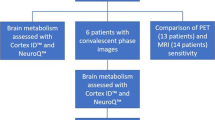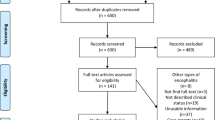Abstract
Purpose
TSPO PET with radioligand [18F]DPA-714 is an emerging molecular imaging technique that reflects cerebral inflammation and microglial activation, and it has been recently used in central nervous system diseases. In this study, we aimed to investigate the neuroinflammation pattern of anti-leucine-rich glioma-inactivated 1 (LGI1) protein autoimmune encephalitis (AIE) and to evaluate its possible correlation with clinical phenotypes.
Methods
Twenty patients with anti-LGI1 encephalitis from the autoimmune encephalitis cohort in Huashan Hospital and ten with other AIE and non-inflammatory diseases that underwent TSPO PET imaging were included in the current study. Increased regional [18F]DPA-714 retention in anti-LGI1 encephalitis was detected on a voxel basis using statistic parametric mapping analysis. Multiple correspondence analysis and hierarchical clustering were conducted for discriminate subgroups in anti-LGI1 encephalitis. Standardized uptake value ratios normalized to the cerebellum (SUVRc) were calculated for semiquantitative analysis of TSPO PET features between different LGI1-AIE subgroups.
Results
Increased regional retention of [18F]DPA-714 was identified in the bilateral hippocampus, caudate nucleus, and frontal cortex in LGI1-AIE patients. Two subgroups of LGI1-AIE patients were distinguished based on the top seven common symptoms. Patients in cluster 1 had a high frequency of facio-brachial dystonic seizures than those in cluster 2 (p = 0.004), whereas patients in cluster 2 had a higher frequency of general tonic–clonic (GTC) seizures than those in cluster 1 (p < 0.001). Supplementary motor area and superior frontal gyrus showed higher [18F]DPA-714 retention in cluster 2 patients compared with those in cluster 1 (p = 0.024; p = 0.04, respectively).
Conclusions
Anti-LGI1 encephalitis had a distinctive molecular imaging pattern presented by TSPO PET scan. LGI1-AIE patients with higher retention of [18F]DPA-714 in the frontal cortex were more prone to present with GTC seizures. Further studies are required for verifying its value in clinical application.



Similar content being viewed by others
Data Availability
All research data supporting this publication are directly available within this publication.
References
Dalmau J, Graus F. Antibody-mediated encephalitis. N Engl J Med. 2018;378:840–51.
Agnes van Sonderen. Anti-LGI1 encephalitis clinical syndrome and long-term follow-up. Neurology. 2016;87:1449–56.
Lai M, Huijbers MGM, Lancaster E, et al. Investigation of LGI1 as the antigen in limbic encephalitis previously attributed to potassium channels: a case series. Lancet Neurol. 2010;9:776–85.
Crisp SJ, Kullmann DM, Vincent A. Autoimmune synaptopathies. Nat Rev Neurosci. 2016;17:103–17.
Petit-Pedrol M, Sell J, Planaguma J, et al. LGI1 antibodies alter Kv1.1 and AMPA receptors changing synaptic excitability, plasticity and memory. Brain. 2018;141:3144–59.
Graus F, Titulaer MJ, Balu R, et al. A clinical approach to diagnosis of autoimmune encephalitis. Lancet Neurol. 2016;15:391–404.
Gresa-Arribas N, Titulaer MJ, Torrents A, et al. Antibody titres at diagnosis and during follow-up of anti-NMDA receptor encephalitis: a retrospective study. Lancet Neurol. 2014;13:167–77.
Arino H, Armangue T, Petit-Pedrol M, et al. Anti-LGI1-associated cognitive impairment: presentation and long-term outcome. Neurology. 2016;87:759–65.
Kotsenas AL, Watson RE, Pittock SJ, et al. MRI findings in autoimmune voltage-gated potassium channel complex encephalitis with seizures: one potential etiology for mesial temporal sclerosis. AJNR Am J Neuroradiol. 2014;35:84–9.
Szots M, Marton A, Kover F, et al. Natural course of LGI1 encephalitis: 3–5 years of follow-up without immunotherapy. J Neurol Sci. 2014;343:198–202.
Tian M, He X, Jin C, et al. Transpathology: molecular imaging-based pathology. Eur J Nucl Med Mol Imaging. 2021;48:2338–50.
Probasco JC, Solnes L, Nalluri A, et al. Abnormal brain metabolism on FDG-PET/CT is a common early finding in autoimmune encephalitis. Neurol Neuroimmunol Neuroinflamm. 2017;4: e352.
Bordonne M, Chawki MB, Doyen M, et al. Brain (18)F-FDG PET for the diagnosis of autoimmune encephalitis: a systematic review and a meta-analysis. Eur J Nucl Med Mol Imaging. 2021;48:3847–58.
Nobili F, Arbizu J, Bouwman F, et al. European Association of Nuclear Medicine and European Academy of Neurology recommendations for the use of brain (18) F-fluorodeoxyglucose positron emission tomography in neurodegenerative cognitive impairment and dementia: Delphi consensus. Eur J Neurol. 2018;25:1201–17.
Sucksdorff M, Matilainen M, Tuisku J, et al. Brain TSPO-PET predicts later disease progression independent of relapses in multiple sclerosis. Brain. 2020;143:3318–30.
de Witte LD, Hoffmann C, van Mierlo HC, et al. Absence of N-methyl-D-aspartate receptor IgG autoantibodies in schizophrenia: the importance of cross-validation studies. JAMA Psychiat. 2015;72:731–3.
Owen DR, Yeo AJ, Gunn RN, et al. An 18-kDa translocator protein (TSPO) polymorphism explains differences in binding affinity of the PET radioligand PBR28. J Cereb Blood Flow Metab. 2012;32:1–5.
Hagens MHJ, Golla SV, Wijburg MT, et al. In vivo assessment of neuroinflammation in progressive multiple sclerosis: a proof of concept study with [(18)F]DPA714 PET. J Neuroinflammation. 2018;15:314.
Van Weehaeghe D, Babu S, De Vocht J, et al. Moving toward multicenter therapeutic trials in amyotrophic lateral sclerosis: feasibility of data pooling using different translocator protein PET radioligands. J Nucl Med. 2020;61:1621–7.
Van Weehaeghe D, Van Schoor E, De Vocht J, et al. TSPO Versus P2X7 as a target for neuroinflammation: an in vitro and in vivo study. J Nucl Med. 2020;61:604–7.
Sciascia S, Radin M, Cecchi I, et al. Identifying phenotypes of patients with antiphospholipid antibodies: results from a cluster analysis in a large cohort of patients. Rheumatology (Oxford). 2021;60:1106–13.
Rebbah S, Delahaye D, Puechmorel S, Nicol F, Marechal P, Berry I. A combined MRI biomarker approach using a non-standard Multiple Factor Analysis. 2018 11th International Congress on Image and Signal Processing, Biomedical Engineering and Informatics (Cisp-Bmei 2018). 2018.
Kenny G, McCann K, O’Brien C, et al. Identification of distinct long COVID clinical phenotypes through cluster analysis of self-reported symptoms. Open Forum Infect Dis. 2022;9:ofac060.
Park S, Choi H, Cheon GJ, Wook Kang K, Lee DS. 18F-FDG PET-CT in anti-LGI1 encephalitis, initial and follow-up findings. Clin Nucl Med. 2015;40:156–8
Seniaray N, Verma R, Ranjan R, Belho E, Mahajan H. Metabolic imaging patterns on 18F-FDG PET in acute and subacute LGI1 autoimmune limbic encephalitis. Clin Nucl Med. 2021;46:e27–8.
Wesselingh R, Butzkueven H, Buzzard K, Tarlinton D, O’Brien TJ, Monif M. Innate immunity in the central nervous system: a missing piece of the autoimmune encephalitis puzzle? Front Immunol. 2019;10:2066.
Bodini B, Poirion E, Tonietto M, et al. Individual mapping of innate immune cell activation is a candidate marker of patient-specific trajectories of worsening disability in multiple sclerosis. J Nucl Med. 2020;61:1043–9.
Politis M, Lahiri N, Niccolini F, et al. Increased central microglial activation associated with peripheral cytokine levels in premanifest Huntington’s disease gene carriers. Neurobiol Dis. 2015;83:115–21.
Ouchi Y, Yagi S, Yokokura M, Sakamoto M. Neuroinflammation in the living brain of Parkinson’s disease. Parkinsonism Relat Disord. 2009;15(Suppl 3):S200-204.
Turner MR, Cagnin A, Turkheimer FE, et al. Evidence of widespread cerebral microglial activation in amyotrophic lateral sclerosis: an [11C](R)-PK11195 positron emission tomography study. Neurobiol Dis. 2004;15:601–9.
Wang J, Jin L, Zhang X, et al. Activated microglia by (18)F-DPA714 PET in a case of anti-LGI1 autoimmune encephalitis. J Neuroimmunol. 2022;368: 577879.
Szots M, Blaabjerg M, Orsi G, et al. Global brain atrophy and metabolic dysfunction in LGI1 encephalitis: a prospective multimodal MRI study. J Neurol Sci. 2017;376:159–65.
Schultze-Amberger J, Pehl D, Stenzel W. LGI-1-positive limbic encephalitis: a clinicopathological study. J Neurol. 2012;259:2478–80.
Glass CK, Saijo K, Winner B, Marchetto MC, Gage FH. Mechanisms underlying inflammation in neurodegeneration. Cell. 2010;140:918–34.
Sinha N, Peternell N, Schroeder GM, et al. Focal to bilateral tonic-clonic seizures are associated with widespread network abnormality in temporal lobe epilepsy. Epilepsia. 2021;62:729–41.
Qiao J, Zhao X, Wang S, et al. Functional and structural brain alterations in encephalitis with LGI1 antibodies. Front Neurosci. 2020;14:304.
International HapMap C. The International HapMap Project. Nature. 2003;426:789–96.
Cosenza-Nashat M, Zhao ML, Suh HS, et al. Expression of the translocator protein of 18 kDa by microglia, macrophages and astrocytes based on immunohistochemical localization in abnormal human brain. Neuropathol Appl Neurobiol. 2009;35:306–28.
Funding
This study was supported by the Clinical Research Plan of SHDC (SHDC2020CR2027B), National and Provincial Multi-disciplinary Cooperation in Diagnosis and Treatment of Major Diseases Capacity Improvement Project (Shanghai Municipal Health Commission); grants from the National Natural Science Foundation of China (81971641); Research project of Shanghai Health Commission (2020YJZX0111); Clinical Research Plan of SHDC (SHDC2020CR1038B); and Medical Innovation Research Project of Shanghai Science and Technology Commission (21Y11903300).
Author information
Authors and Affiliations
Contributions
Jingguo Wang: drafting/revision of the manuscript for content, including medical writing for content; major role in the acquisition of data; study concept or design; analysis or interpretation of data. Jingjie Ge: drafting/revision of the manuscript for content, including medical writing for content; major role in the acquisition of data; study concept or design; analysis or interpretation of data. Lei Jin: major role in the acquisition of data; analysis or interpretation of data. Bo Deng: major role in the acquisition of data; analysis or interpretation of data. Weijun Tang: major role in the acquisition of data. Hai Yu: major role in the acquisition of data. Xiang Zhang: major role in the acquisition of data. Xiaoni Liu: major role in the acquisition of data. Chuantao Zuo: major role in the acquisition of data; study concept or design. Xiangjun Chen: drafting/revision of the manuscript for content; major role in the acquisition of data; study concept or design.
Corresponding authors
Ethics declarations
Ethics approval
This study protocol was approved by the institutional review board of Huashan Hospital, Fudan University.
Consent to participate
Written informed consent was obtained from all individual participants included in the study.
Consent for publication
The authors affirm that human research participants provided informed consent for publication of the images in Fig. 1a.
Conflict of interest
The authors declare no competing interests.
Additional information
Publisher's note
Springer Nature remains neutral with regard to jurisdictional claims in published maps and institutional affiliations.
This article is part of the Topical Collection on Neurology.
Supplementary Information
Below is the link to the electronic supplementary material.
Supplementary Figure 1
(PDF 92.8 kb)
Supplementary Figure 2
(PDF 149 kb)
Supplementary Table 1
(XLSX 10.6 kb)
Rights and permissions
Springer Nature or its licensor (e.g. a society or other partner) holds exclusive rights to this article under a publishing agreement with the author(s) or other rightsholder(s); author self-archiving of the accepted manuscript version of this article is solely governed by the terms of such publishing agreement and applicable law.
About this article
Cite this article
Wang, J., Ge, J., Jin, L. et al. Characterization of neuroinflammation pattern in anti-LGI1 encephalitis based on TSPO PET and symptom clustering analysis. Eur J Nucl Med Mol Imaging 50, 2394–2408 (2023). https://doi.org/10.1007/s00259-023-06190-8
Received:
Accepted:
Published:
Issue Date:
DOI: https://doi.org/10.1007/s00259-023-06190-8




